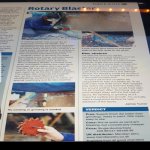peterf
Member
I want to take my keel back to bear metal and prime with many coats of primacon. I've used a wire brush on an angle grinder to do this before, it works but no fun.
I'm curious whether I should try purchasing an add-on for my Karcher to do sandblasting instead?
Has anyone tried it and how many bags of 25kg sand would I need for a keel on a gibsea 312?
I'm curious whether I should try purchasing an add-on for my Karcher to do sandblasting instead?
Has anyone tried it and how many bags of 25kg sand would I need for a keel on a gibsea 312?

